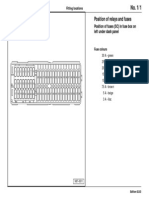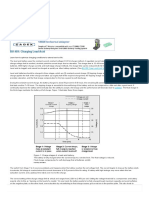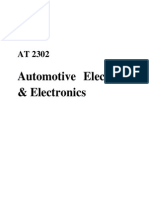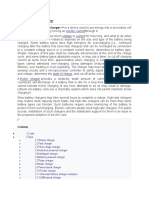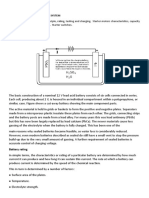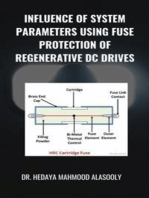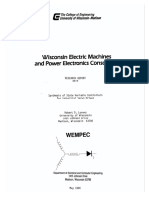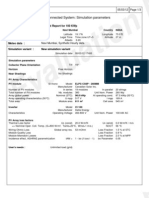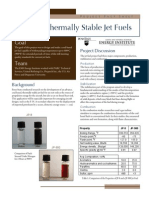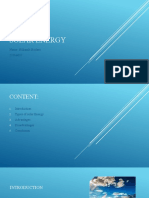Guide To Battery Management
Guide To Battery Management
Uploaded by
joonimCopyright:
Available Formats
Guide To Battery Management
Guide To Battery Management
Uploaded by
joonimOriginal Description:
Original Title
Copyright
Available Formats
Share this document
Did you find this document useful?
Is this content inappropriate?
Copyright:
Available Formats
Guide To Battery Management
Guide To Battery Management
Uploaded by
joonimCopyright:
Available Formats
Astrosyn
Guide to Battery Management
Astrosyn International Technology Ltd
Lawtronics Division,
The Old Courthouse, New Rd Ave,
Chatham, Kent, ME4 6BE, England
Tel +44 (0) 1634 815175
Fax +44(0) 1634 826552
www.astrosyn.com
Astrosyn
GUIDE TO BATTERY MANAGEMENT
Introduction
Our standard range of battery chargers caters for sealed
lead acid, nickel cadmium and nickel metal hydride
battery types. Each cell type has certain advantages,
and the decision which to use in a particular application
may depend on economic considerations as much as
technical desirability. A compromise is often needed.
Characteristic
SLA
NiCd
NiMH
Energy Density (Wh/kg)
30
40
60
Volts/cell (nominal)
2.0
1.2
1.2
Operating cycles (typical)
500
1000
800
Self discharge (%/month)
3%
30%
30%
Equivalent series resistance
low
very low
medium
Operating temperature (o C)
5 to 35
10 to 45
10 to 40
Maximum charge rate
0.25C
2C
1C
Charge method
CV
CC
CC
Memory effect
No
Yes
Yes
To prevent overcharging,
accurate charge termination
is achieved by using proven
techniques. In addition,
intelligent chargers have to
accommodate the erratic
characteristics of abused,
unformed or old cells, as well
as the effects of protection
circuitry and variations in
operating temperature and
contact resistance.
Generally the problems are
not as pronounced in the
constant voltage charging of
sealed lead acid cells
compared with constant
current charging of nickel
cadmium and nickel metal
hydride cells charged at
higher C rates.
Battery Charging
The operating life of all rechargeable batteries is determined by
four major factors:
Rate of discharge
Depth of discharge
Operating and ambient temperature
Charging technique: constant voltage (CV) or constant
current (CC).
The first three are determined by the
equipment designer, but if the incorrect
charging technique is adopted, the
benefit of good design is minimised,
resulting in battery service life and
performance being significantly
degraded.
With all types of cells, it is only possible
to achieve optimum performance when
operating within the correct
management of charge and discharge
characteristics.
SLA Battery
Charging
Sealed lead acid batteries
require current limited
constant voltage charging.
Cells should not be charged
in less than four or five hours
for optimum life (C/4 rate).
Accurate charge voltage
control is essential.
The charger model is
determined by the following
application parameters:
Charge time
required
Cyclic or standby
operation
Operating
temperature
Astrosyn International Technology Ltd
Lawtronics Division, The Old Courthouse, New Rd Ave, Chatham, Kent, ME4 6BE, England
Tel +44 (0) 1634 815175 Fax +44 (0) 1634 826552 www.astrosyn.com
GUIDE TO BATTERY MANAGEMENT
Initial current limit
Permissible overcharge
Manufacturers of SLA batteries recommend constant voltage
current limited charging either from a basic single voltage taper
charger or a multistage charger.
Standby Application
Astrosyn
If the battery is fully or
deeply discharged, a
multistage charger initially
generates a small forming
current to restore the battery
to 1.75V/cell (e.g. 10.5V in a
12V battery), before
increasing the bulk current
to the maximum design
limit. The battery voltage
then rises towards the limit
of 2.45V/cell (14.7V), and the
current starts to decay.
When the battery voltage
limit is achieved, the charger
voltage reduces to 2.25V/cell
(13.5V), and the current
continues to fall to a trickle.
Full battery capacity is
recovered when the trickle
current falls to 0.01C Amps.
Where the SLA application is for standby use and the battery is
seldom required to deliver power a single stage current limited
float charger preset to 2.25V/cell at normal temperatures is
adequate. At this potential, the battery will not overcharge and
may remain connected indefinitely without incurring damage.
The trickle current continues
to decay until the natural
maintenance level of
approximately 0.001C Amps
is reached.
Standby and Cyclic Application
The battery can remain
connected to the charger in
this state continuously.
The maximum charge voltage recommended by most battery
manufacturers is 2.45V/cell with a maximum in-rush current of
0.25C Amps. This limits the safe charge time to approximately 5
hours to reach 90% capacity. Exceeding the voltage or current limit
is detrimental to battery life. Some SLA manufacturers permit a
larger in-rush current, but the additional cost of the enhanced
charger may not be acceptable.
If a single stage charger set at 2.45V/cell remains connected to a
battery, the high residual value of trickle current causes
overcharge which cannot be absorbed into cells. The excess
energy is dissipated as heat, resulting in reduced operating life and
performance. Reduction in cell voltage to the float value of 2.25V
minimises the overcharge current to a safe, sustainable level, at the
cost of increased charge time.
Optimum fast charging is obtained by combining the cyclic and
standby modes in a multistage managed charger with a re-forming
mode for initial recovery.
In summary, the multistage
SLA charging process
sequence is:
Step 1
Forming current until
discharged cell voltage rises
to 1.75V/cell.
Astrosyn International Technology Ltd
Lawtronics Division, The Old Courthouse, New Rd Ave, Chatham, Kent, ME4 6BE, England
Tel +44 (0) 1634 815175 Fax +44 (0) 1634 826552 www.astrosyn.com
Astrosyn
GUIDE TO BATTERY MANAGEMENT
Step 2
Voltage Depression
Memory Effect
Bulk charge to 2.45V/cell (approximately 80% returned capacity).
Step 3
Continuous trickle charge at 2.25V/cell, reaching 90% of capacity
after 5-6 hours.
SLA Battery Charge Time
The approximate charge time for an SLA battery in good condition
and not over-discharged can be calculated as:
Time (h) = (Battery Ah Capacity / Max Charger Current A) + 2h
One effect of continual
overcharge and high
temperature operation is
voltage depression. The
voltage of each cell in the
battery pack may be reduced
by up to 150mV reducing
useful operating hours
significantly.
This is a more probable
reason for loss of capacity
NiCd and NiMH Battery Charging
Standard Charge
For many applications using NiCd and NiMH batteries, a standard
overnight constant current charge for a period of 14 hours is
suitable. This equates to a rate of C/10, where C is the Ampere hour
capacity of the cell. Extended constant current charge at the C/10
rate has little effect on the overall performance or operating life of
NiCd and NiMH batteries. It is however good practice to
discontinue the charge within 24 hours to minimise long term
effects, particularly when using NiMH cells.
If accelerated fast charge is required at rates of typically C/5 to 2C,
the correct management of the charge characteristic is vital to
prevent battery damage.
than the near mythical
"memory effect", which is
only apparent after a cell has
been subjected to precise
repetitive shallow cycling.
Both voltage depression and
memory effect can be
removed by a controlled
conditioning discharge to a
known end point voltage.
NiCd and NiMH Battery Charge Time
The approximate charge time for NiCd and NiMH batteries in good
condition and not over-discharged can be calculated as:
Time (h) = (Battery Ah Capacity / Max Charger Current A) + 20%
Astrosyn International Technology Ltd
Lawtronics Division, The Old Courthouse, New Rd Ave, Chatham, Kent, ME4 6BE, England
Tel +44 (0) 1634 815175 Fax +44 (0) 1634 826552 www.astrosyn.com
You might also like
- Touran FuseboxDocument16 pagesTouran FuseboxRiki Nurzaman75% (4)
- Charging Information For Lead Acid Batteries - Battery UniversityDocument92 pagesCharging Information For Lead Acid Batteries - Battery UniversityarthurNo ratings yet
- Lead-X Tech Manual PDFDocument20 pagesLead-X Tech Manual PDFgenial72No ratings yet
- Battery CalculationsDocument6 pagesBattery CalculationsMandip Pokharel100% (1)
- Battery Sizing Calculation Methodology: Ieee STD 485 (1997, R2003) IEEE STD 1115 (2000, R2005)Document7 pagesBattery Sizing Calculation Methodology: Ieee STD 485 (1997, R2003) IEEE STD 1115 (2000, R2005)Thirumal100% (1)
- Scottishpower 14 FullDocument4 pagesScottishpower 14 FullSaurabh SinghNo ratings yet
- Ek Kaynak LM2576Document19 pagesEk Kaynak LM2576Şakir BayramNo ratings yet
- Battery Test Procedures 1997Document7 pagesBattery Test Procedures 1997Tara P. PradhanNo ratings yet
- Ev Unit6Document30 pagesEv Unit6ashuamair7No ratings yet
- Basic Battery Princeple Avition CourseDocument17 pagesBasic Battery Princeple Avition CourseabyNo ratings yet
- Three Stage Battery Charge SLA PDFDocument18 pagesThree Stage Battery Charge SLA PDFzigoto_2n0% (1)
- Harging EAD CID: Learn How To Optimize Charging Conditions To Extend Service LifeDocument4 pagesHarging EAD CID: Learn How To Optimize Charging Conditions To Extend Service LifebigsloNo ratings yet
- Care and Maintenance of Lead-Acid BatteriesDocument11 pagesCare and Maintenance of Lead-Acid BatteriesBalakrishnan Pedda GovindierNo ratings yet
- Panasonic NiMH ChargeMethodsDocument2 pagesPanasonic NiMH ChargeMethodsMarcio M GuedesNo ratings yet
- Ni-Cd Battery Maintenance ManualDocument18 pagesNi-Cd Battery Maintenance Manualhathanhchinh2279No ratings yet
- Ex 2. To Acquaint With The Charging Methods of Batteries and Calculation of Their Life CycleDocument23 pagesEx 2. To Acquaint With The Charging Methods of Batteries and Calculation of Their Life CycleKunal TanwarNo ratings yet
- 2022 ... Pocket Battery Manual - HengmingDocument16 pages2022 ... Pocket Battery Manual - HengmingProfesional19No ratings yet
- Acceptation de ChargeDocument14 pagesAcceptation de ChargebenaliNo ratings yet
- 504pet23 PDFDocument9 pages504pet23 PDFsickdogNo ratings yet
- Uninterruptible Power Supply Battery Acceptance/Capacity Test ProcedureDocument9 pagesUninterruptible Power Supply Battery Acceptance/Capacity Test Proceduresjaveeds2003No ratings yet
- Manual of Ni-Cd Pocket Type BatteryDocument17 pagesManual of Ni-Cd Pocket Type BatteryCasanova FernandoNo ratings yet
- Battery Management GuideDocument10 pagesBattery Management GuideR.S. Kumaraswamy100% (1)
- User Manual Gn-EnglishDocument17 pagesUser Manual Gn-EnglishMinh Chí NguyễnNo ratings yet
- CZC7 Automatic Charger: Operating InstructionDocument10 pagesCZC7 Automatic Charger: Operating InstructionJavier VillelaNo ratings yet
- Tutorial BatteryChargersDocument3 pagesTutorial BatteryChargersManuelNo ratings yet
- s65 Instruction Manual v2.0Document29 pagess65 Instruction Manual v2.0Julian COULETNo ratings yet
- DC Power Supply in Medium Voltage Electrical Distribution SystemDocument8 pagesDC Power Supply in Medium Voltage Electrical Distribution SystemLowell Estrella-SchneiderNo ratings yet
- Battery Testing: Keysight TechnologiesDocument10 pagesBattery Testing: Keysight Technologieswahlgren9483No ratings yet
- 3A Battery Charger PDFDocument6 pages3A Battery Charger PDFRamazan ÖzenNo ratings yet
- Battery ChargingDocument9 pagesBattery Chargingtaiwong167No ratings yet
- BatteriesDocument83 pagesBatteriesShubham DawleNo ratings yet
- Battery Charging Guide - 6 VoltDocument5 pagesBattery Charging Guide - 6 VoltKidus DawitNo ratings yet
- Battery Charge - Discharge BattconDocument5 pagesBattery Charge - Discharge BattconmatarakiNo ratings yet
- 1.7 Handling Manual enDocument4 pages1.7 Handling Manual eningridNo ratings yet
- General Information On Sealed Nickel Cadmium BatteriesDocument9 pagesGeneral Information On Sealed Nickel Cadmium BatteriesB.Kailash Krishna PrasadNo ratings yet
- Automotive Electrical & ElectronicsDocument83 pagesAutomotive Electrical & ElectronicsSathya NarayananNo ratings yet
- SIS-Preventive Maintenance For BatteriesDocument2 pagesSIS-Preventive Maintenance For BatteriesmkNo ratings yet
- Battery Sizing - Open ElectricalDocument7 pagesBattery Sizing - Open Electricalhn_317No ratings yet
- CEL PROJECTDocument17 pagesCEL PROJECTCHAITANYA KULKARNINo ratings yet
- A Complete Guide To Battery ChargingDocument4 pagesA Complete Guide To Battery ChargingAman SinghNo ratings yet
- Battery Charger: Rechargeable Battery Electric Current Voltage CurrentDocument12 pagesBattery Charger: Rechargeable Battery Electric Current Voltage CurrentRonaldNo ratings yet
- Battery Charging TutorialDocument3 pagesBattery Charging TutorialPaul Cortes OlivosNo ratings yet
- A Guide To Battery ChargingDocument7 pagesA Guide To Battery ChargingRohit BhogleNo ratings yet
- Battery Charging Guide - 2 VoltDocument4 pagesBattery Charging Guide - 2 VoltR.ArumugamNo ratings yet
- Automotive Electrical and Electronics EngineeringDocument5 pagesAutomotive Electrical and Electronics EngineeringKarthik SwaminathanNo ratings yet
- T105RE TrojanRE Data SheetsDocument2 pagesT105RE TrojanRE Data SheetsMtech ServSolNo ratings yet
- VRLA BatteryDocument23 pagesVRLA BatteryAlexander Mccormick100% (1)
- Battery HandbookDocument7 pagesBattery Handbookcheguevara2010100% (1)
- 2021 - 4.0 Storage For EVs - UploadDocument44 pages2021 - 4.0 Storage For EVs - Uploadsahilparveenyadav12345No ratings yet
- Nergie-: Diesel Engine Starting Batteries Guide and WorksheetDocument7 pagesNergie-: Diesel Engine Starting Batteries Guide and WorksheetAlexander OngNo ratings yet
- Application Note 68 December 1996:, LTC and LT Are Registered Trademarks of Linear Technology CorporationDocument36 pagesApplication Note 68 December 1996:, LTC and LT Are Registered Trademarks of Linear Technology CorporationHahdNo ratings yet
- Lead Acid Battery Charger Circuits - Homemade Circuit ProjectsDocument25 pagesLead Acid Battery Charger Circuits - Homemade Circuit ProjectsDhe KencoesNo ratings yet
- IntroductionDocument8 pagesIntroductionmanuNo ratings yet
- Samsung 2600mah ICR18650-26CDocument17 pagesSamsung 2600mah ICR18650-26CStreet_skNo ratings yet
- CB2410AC Manual PDFDocument4 pagesCB2410AC Manual PDFdinhvuNo ratings yet
- Marine Electrics Made Simple or How to Keep the Batteries ChargedFrom EverandMarine Electrics Made Simple or How to Keep the Batteries ChargedNo ratings yet
- A Case Study for a Single-Phase Inverter Photovoltaic System of a Three-Bedroom Apartment Located in Alexandria, Egypt: building industry, #0From EverandA Case Study for a Single-Phase Inverter Photovoltaic System of a Three-Bedroom Apartment Located in Alexandria, Egypt: building industry, #0No ratings yet
- Boat Maintenance Companions: Electrics & Diesel Companions at SeaFrom EverandBoat Maintenance Companions: Electrics & Diesel Companions at SeaNo ratings yet
- Static-Inverter 1.0: A Complete Design Process to Convert D.C. to A.C. Electricity Using the Astable-MultivibratorFrom EverandStatic-Inverter 1.0: A Complete Design Process to Convert D.C. to A.C. Electricity Using the Astable-MultivibratorNo ratings yet
- Influence of System Parameters Using Fuse Protection of Regenerative DC DrivesFrom EverandInfluence of System Parameters Using Fuse Protection of Regenerative DC DrivesNo ratings yet
- On Battery State of Charge Estimation - A New Mixed Algorithm PDFDocument6 pagesOn Battery State of Charge Estimation - A New Mixed Algorithm PDFjoonimNo ratings yet
- Some Tips For Charging From USB Sources-Pt2Document4 pagesSome Tips For Charging From USB Sources-Pt2joonimNo ratings yet
- Li-Ion Battery Emulation Circuit by Microcontroller PDFDocument3 pagesLi-Ion Battery Emulation Circuit by Microcontroller PDFjoonimNo ratings yet
- Advanced Power Converters For More Electric Aircraft ApplicationsDocument6 pagesAdvanced Power Converters For More Electric Aircraft ApplicationsjoonimNo ratings yet
- Lm317 Regulated Battery Charger Circuit - Electronic CircuitsDocument10 pagesLm317 Regulated Battery Charger Circuit - Electronic CircuitsjoonimNo ratings yet
- Servo Motors and Its ApplicationsDocument19 pagesServo Motors and Its ApplicationsjoonimNo ratings yet
- AMC-servo Drive OverviewDocument28 pagesAMC-servo Drive OverviewjoonimNo ratings yet
- Synthesis of State Variable Controllers For Industrial Servo Drives (Lorenz) 86-08Document6 pagesSynthesis of State Variable Controllers For Industrial Servo Drives (Lorenz) 86-08joonimNo ratings yet
- Battery GuideDocument1 pageBattery GuidejoonimNo ratings yet
- 520L0893 PDFDocument240 pages520L0893 PDFthailanNo ratings yet
- Canadian With 100 KWDocument3 pagesCanadian With 100 KWsourabh purohitNo ratings yet
- From Feedstocks To Final Products: Biomass ConversionDocument4 pagesFrom Feedstocks To Final Products: Biomass ConversionJoshi kartikNo ratings yet
- DTU Wind Energy Report I 46Document73 pagesDTU Wind Energy Report I 46hemal4379No ratings yet
- Manual Sundaya-Apple - 15 PDFDocument1 pageManual Sundaya-Apple - 15 PDFEduSizaNo ratings yet
- Absorber:: Reactions: N O 2no + O 3NO + H O + NoDocument4 pagesAbsorber:: Reactions: N O 2no + O 3NO + H O + NoShivam PandyaNo ratings yet
- Harish SolankiDocument58 pagesHarish Solankiyogesh pandeyNo ratings yet
- IJCRT1803270Document13 pagesIJCRT1803270Chandra Shekhar SahuNo ratings yet
- Introduction To TTL, Its Activities and Future CooperationDocument23 pagesIntroduction To TTL, Its Activities and Future CooperationSaroj GautamNo ratings yet
- 2 Djoko Santoso CCS-CCUS - NZEDocument42 pages2 Djoko Santoso CCS-CCUS - NZEgunawan wibisanaNo ratings yet
- Energy Storage TechnologyDocument12 pagesEnergy Storage Technologyrhodz_24No ratings yet
- 14 - Automated Solar Operated Water PurifierDocument1 page14 - Automated Solar Operated Water PurifierRajesh RamaswamyNo ratings yet
- Power PlantDocument388 pagesPower PlantlvsaruNo ratings yet
- Fyp Report Full FinalDocument74 pagesFyp Report Full FinalMohammad SaleemNo ratings yet
- Certificado de FabricaDocument8 pagesCertificado de FabricaCristian MenesesNo ratings yet
- 02 03 2022 Shift3Document43 pages02 03 2022 Shift3SURAJ MALLAHNo ratings yet
- Advanced Thermally Stable Jet FuelsDocument2 pagesAdvanced Thermally Stable Jet FuelsgeorgecmuNo ratings yet
- Literature Review Solar PVDocument4 pagesLiterature Review Solar PVafmzatvuipwdal100% (1)
- PMFIAS Environment First Vs Second EditionDocument181 pagesPMFIAS Environment First Vs Second Editionchaitanyasktp9414100% (2)
- CompressorDocument22 pagesCompressorSai Krishna Kiran B V100% (2)
- Nios Tma EnglishDocument2 pagesNios Tma EnglishSoham AhluwaliaNo ratings yet
- Presentation RIPDocument26 pagesPresentation RIPAbhishek Prakash SrivastavaNo ratings yet
- Gyser Catalogue 2016Document44 pagesGyser Catalogue 2016Dinesh Durai RajNo ratings yet
- Increased Energy Yield of 50% at Flat Roof - Hanitsch Quaschning PDFDocument4 pagesIncreased Energy Yield of 50% at Flat Roof - Hanitsch Quaschning PDFshibly anastasNo ratings yet
- Add-Bab Xii.3. TPG Gi JenepontoDocument17 pagesAdd-Bab Xii.3. TPG Gi JenepontoPrasetiyo HanantoNo ratings yet
- THESIS Synopsysis NET ZERO ENERGY BUILDING AND HOTELDocument4 pagesTHESIS Synopsysis NET ZERO ENERGY BUILDING AND HOTELKranthikumar PrathiNo ratings yet
- SOLAR ENERGY NilDocument12 pagesSOLAR ENERGY NilBodra NilNo ratings yet
- Report of An Industrial Visit To Reliance Thermal Power Plant, DahanuDocument8 pagesReport of An Industrial Visit To Reliance Thermal Power Plant, DahanuAmeya VirkudNo ratings yet
